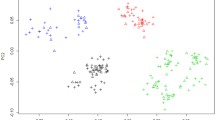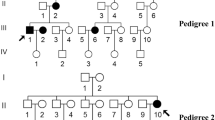Abstract
Recent reports suggest that the mitochondrial DNA (mtDNA) poly-C tract (16184–16193 polycytosine tract) variant and its relevant haplogroup lineages could be associated with type 2 diabetes mellitus (T2DM); however, subsequent surveys of this relationship have yielded conflicting results, some finding significant associations and others reporting no significant effect. Therefore, to assess the possible contribution of mtDNA haplogroup-specific variants to the occurrence of T2DM, we performed a population-based study on Korean diabetes cases and controls. The distribution of 16184–16193 poly-C tract variants and their relevant haplogroup B lineage were typed in the Korean population using APLP/PCR–RFLP/sequencing on a total of 497 T2DM cases and 500 corresponding controls. While the haplogroup B distribution of the T2DM cases did not differ significantly from the controls, the frequency of an interrupted poly-C tract with T16189C variation harboring mtDNA haplogroup B was significantly higher in controls compared to the T2DM patients (OR 0.106, 95 % CI 0.002–0.785, p = 0.012). Thus, our data imply that the specific mtDNA haplogroup B lineage retaining the interrupted poly-C tract is significantly associated with reduced susceptibility to T2DM in the Korean population, although functional studies with larger sample size from diverse regions of different ethnic populations are necessary to further substantiate these findings.

Similar content being viewed by others
References
Andrews RM, Kubacka I, Chinnery PF, Lightowlers RN, Turnbull DM, Howell N (1999) Reanalysis and revision of the Cambridge reference sequence for human mitochondrial DNA. Nat Genet 23:147
Atig RK, Hsouna S, Beraud-Colomb E, Abdelhak S (2009) Mitochondrial DNA: properties and applications. Arch Inst Pasteur Tunis 86:3–14
Ballinger SW, Shoffner JM, Hedaya EV, Trounce I, Polak MA, Koontz DA, Wallace DC (1992) Maternally transmitted diabetes and deafness associated with a 10.4 kb mitochondrial DNA deletion. Nat Genet 1:11–15
Casteels K, Ong K, Phillips D, Bendall H, Pembrey M (1999) Mitochondrial 16189 variant, thinness at birth, and type-2 diabetes. ALSPAC study team. Avon Longitudinal Study of Pregnancy and Childhood. Lancet 353:1499–1500
Chinnery PF, Elliott HR, Patel S, Lambert C, Keers SM, Durham SE, McCarthy MI, Hitman GA, Hattersley AT, Walker M (2005) Role of the mitochondrial DNA 16184-16193 poly-C tract in type 2 diabetes. Lancet 366:1650–1651
Das S, Bennett AJ, Sovio U, Ruokonen A, Martikainen H, Pouta A, Hartikainen AL, Franks S, Elliott P, Poulton J et al (2007) Detailed analysis of variation at and around mitochondrial position 16189 in a large Finnish cohort reveals no significant associations with early growth or metabolic phenotypes at age 31 years. J Clin Endocrinol Metab 92:3219–3223
De Fronzo RA (1988) Lilly Lecture 1987. The triumvirate: beta-cell, muscle, liver. A collusion responsible for NIDDM. Diabetes 37:667–687
Faul F, Erdfelder E, Buchner A, Lang AG (2009) Statistical power analyses using G*Power 3.1: tests for correlation and regression analyses. Behav Res Methods 41:1149–1160
Fay MP (2010) Confidence intervals that match Fisher’s exact or Blaker’s exact tests. Biostatistics 11:373–374
Gill-Randall R, Sherratt EJ, Thomas AW, Gagg JW, Lee A, Alcolado JC (2001) Analysis of a polycytosine tract and heteroplasmic length variation in the mitochondrial DNA D-loop of patients with diabetes, MELAS syndrome and race-matched controls. Diabet Med 18:413–416
Hsouna S, Ben Halim N, Lasram K, Arfa I, Jamoussi H, Bahri S, Ammar SB, Miladi N, Abid A, Abdelhak S et al (2015) Association study of mitochondrial DNA polymorphisms with type 2 diabetes in Tunisian population. Mitochondrial DNA 26:367–372
Jin HJ, Tyler-Smith C, Kim W (2009) The peopling of Korea revealed by analyses of mitochondrial DNA and Y-chromosomal markers. PLoS ONE 4:e4210
Kim JH, Park KS, Cho YM, Kang BS, Kim SK, Jeon HJ, Kim SY, Lee HK (2002) The prevalence of the mitochondrial DNA 16189 variant in non-diabetic Korean adults and its association with higher fasting glucose and body mass index. Diabet Med 19:681–684
Kim KC, Jin HJ, Kim W (2012) Mitochondrial haplogroup B is negatively associated with elite Korean endurance athlete status. Genes Genome 34:569–573
Kivisild T, Tolk HV, Parik J, Wang Y, Papiha SS, Bandelt HJ, Villems R (2002) The emerging limbs and twigs of the East Asian mtDNA tree. Mol Biol Evol 19:1737–1751
Liou CW, Lin TK, Huei Weng H, Lee CF, Chen TL, Wei YH, Chen SD, Chuang YC, Weng SW, Wang PW (2007) A common mitochondrial DNA variant and increased body mass index as associated factors for development of type 2 diabetes: additive effects of genetic and environmental factors. J Clin Endocrinol Metab 92:235–239
Mohlke KL, Jackson AU, Scott LJ, Peck EC, Suh YD, Chines PS, Watanabe RM, Buchanan TA, Conneely KN, Erdos MR et al (2005) Mitochondrial polymorphisms and susceptibility to type 2 diabetes-related traits in Finns. Hum Genet 118:245–254
Pakendorf B, Stoneking M (2005) Mitochondrial DNA and human evolution. Annu Rev Genomics Hum Genet 6:165–183
Park KS, Chan JC, Chuang LM, Suzuki S, Araki E, Nanjo K, Ji L, Ng M, Nishi M, Furuta H, Study Group of Molecular Diabetology in Asia et al (2008) A mitochondrial DNA variant at position 16189 is associated with type 2 diabetes mellitus in Asians. Diabetologia 51:602–608
Poulton J, Marchington DR, Scott-Brown M, Phillips DI, Hagelberg E (1998) Does a common mitochondrial DNA polymorphism underlie susceptibility to diabetes and the thrifty genotype? Trends Genet 14:387–389
Poulton J, Bednarz AL, Scott-Brown M, Thompson C, Macaulay VA, Simmons D (2002a) The presence of a common mitochondrial DNA variant is associated with fasting insulin levels in Europeans in Auckland. Diabet Med 19:969–971
Poulton J, Luan J, Macaulay V, Hennings S, Mitchell J, Wareham NJ (2002b) Type 2 diabetes is associated with a common mitochondrial variant: evidence from a population-based case-control study. Hum Mol Genet 11:1581–1583
Saxena R, de Bakker PI, Singer K, Mootha V, Burtt N, Hirschhorn JN, Gaudet D, Isomaa B, Daly MJ, Groop L et al (2006) Comprehensive association testing of common mitochondrial DNA variation in metabolic disease. Am J Hum Genet 79:54–61
Smyth S, Heron A (2006) Diabetes and obesity: the twin epidemics. Nat Med 12:75–80
Suresh K, Chandrashekara S (2012) Sample size estimation and power analysis for clinical research studies. J Hum Reprod Sci 5:7–13
Suzuki Y, Iizuka T, Kobayashi T, Nishikawa T, Atsumi Y, Kadowaki T, Oka Y, Kadowaki H, Taniyama M, Hosokawa K et al (1997) Diabetes mellitus associated with the 3243 mitochondrial tRNA(Leu)(UUR) mutation: insulin secretion and sensitivity. Metabolism 46:1019–1023
Tanaka M, Cabrera VM, González AM, Larruga JM, Takeyasu T, Fuku N, Guo LJ, Hirose R, Fujita Y, Kurata M et al (2004) Mitochondrial genome variation in eastern Asia and the peopling of Japan. Genome Res 14:1832–1850
Taylor RW, Turnbull DM (2005) Mitochondrial DNA mutations in human disease. Nat Rev Genet 6:389–402
Torroni A, Huoponen K, Francalacci P, Petrozzi M, Morelli L, Scozzari R, Obinu D, Savontaus ML, Wallace DC (1996) Classification of European mtDNAs from an analysis of three European populations. Genetics 144:1835–1850
Turner N, Heilbronn LK (2008) Is mitochondrial dysfunction a cause of insulin resistance? Trends Endocrinol Metab 19:324–330
Umetsu K, Tanaka M, Yuasa I, Adachi N, Miyoshi A, Kashimura S, Park KS, Wei YH, Watanabe G, Osawa M (2005) Multiplex amplified product-length polymorphism analysis of 36 mitochondrial single-nucleotide polymorphisms for haplogrouping of East Asian populations. Electrophoresis 26:91–98
van den Ouweland JM, Lemkes HH, Ruitenbeek W, Sandkuijl LA, de Vijlder MF, Struyvenberg PA, van de Kamp JJ, Maassen JA (1992) Mutation in mitochondrial tRNA(Leu)(UUR) gene in a large pedigree with maternally transmitted type II diabetes mellitus and deafness. Nat Genet 1:368–371
Wallace DC (2005) A mitochondrial paradigm of metabolic and degenerative diseases, aging, and cancer: a dawn for evolutionary medicine. Annu Rev Genet 39:359–407
Wang PW, Lin TK, Weng SW, Liou CW (2009) Mitochondrial DNA variants in the pathogenesis of type 2 diabetes: relevance of asian population studies. Rev Diabet Stud 6:237–246
Ye Z, Gillson C, Sims M, Khaw KT, Plotka M, Poulton J, Langenberg C, Wareham NJ (2013) The association of the mitochondrial DNA OriB variant (16184-16193 polycytosine tract) with type 2 diabetes in Europid populations. Diabetologia 56:1907–1913
Acknowledgments
The biospecimens for this study were provided by National Biobank of Korea (KOBB-2012-1046). They also thank S.S. Hong for technical assistance during the course of this work. Comments and discussion on this manuscript by Chris Tyler-Smith (The Wellcome Trust) were also greatly appreciated. This work was supported by grants from National Research Foundation of Korea (NRF-2012R1A1A2041245) with additional support from National Forensic Service of Korea (2014). This work was also supported in part by DANKOOK ChemBio Specialization for Creative Korea-II (2014).
Author information
Authors and Affiliations
Corresponding author
Ethics declarations
Bioethical statements
The study was approved by the Ethics Committee and Institutional Review Board of Dankook University, Korea.
Conflict of interest
The authors declare no conflict of interest.
Rights and permissions
About this article
Cite this article
Kim, K.C., Lee, S.G., Kim, J.A. et al. The prevalence of an interrupted poly-C tract variant harboring mitochondrial DNA haplogroup B and its association with reduced susceptibility to type 2 diabetes in Korea. Genes Genom 37, 939–944 (2015). https://doi.org/10.1007/s13258-015-0323-0
Received:
Accepted:
Published:
Issue Date:
DOI: https://doi.org/10.1007/s13258-015-0323-0




